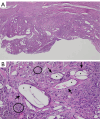Increased cortical density in popliteal lymphadenopathy as a promising radiological sign to help differentiate adverse local tissue reaction from infections in complications following a knee arthroplasty-three case reports
- PMID: 39544470
- PMCID: PMC11558495
- DOI: 10.21037/qims-24-378
Increased cortical density in popliteal lymphadenopathy as a promising radiological sign to help differentiate adverse local tissue reaction from infections in complications following a knee arthroplasty-three case reports
Abstract
Background: Total knee arthroplasty (TKA) is an effective surgical procedure for managing advanced osteoarthritis of the knee, significantly reducing pain and improving function. However, some patients experience complications leading to revision surgery, often caused by periprosthetic joint infection (PJI) in early failures and adverse local tissue reactions (ALTR) or aseptic loosening in late failures. Differentiating between PJI and ALTR is crucial because their clinical presentations can overlap, yet their treatments are distinct. While traditional imaging like radiography is useful for assessing alignment and detecting osteolysis, it may miss subtle pathological changes. Computed tomography (CT) has been increasingly utilized to provide additional diagnostic detail, especially regarding lymphadenopathy, which has been linked to septic complications in hip prostheses. However, the role of popliteal lymphadenopathy (PLN) in knee prosthesis complications remains unexplored.
Case description: We present three cases of knee prosthesis complications, diagnosed as either septic or aseptic, where CT imaging revealed distinct patterns of PLN. In the first case, which involved septic loosening, three enlarged PLNs with rounded morphology, normal density, and an absent fatty hilum were observed. The second case, complicated by ALTR and a periprosthetic fracture, showed six PLNs with increased cortical density but a preserved fatty hilum. The third and final case of aseptic loosening revealed three PLNs with increased cortical density and prosthetic debris in the popliteal recess. These findings suggest a range of PLN characteristics depending on the underlying complication, with distinct differences in morphology and cortical density observed between septic and aseptic cases.
Conclusions: The presence and characteristics of PLN may serve as a valuable imaging biomarker for diagnosing and differentiating knee prosthesis complications. CT evaluation of PLNs could enhance diagnostic accuracy, particularly in distinguishing between PJI and ALTR, prompting further research to validate these findings and explore their diagnostic potential.
Keywords: Periprosthetic joint infection (PJI); adverse local tissue reaction (ALTR); case report; dense cortex; popliteal lymph nodes.
2024 AME Publishing Company. All rights reserved.
Conflict of interest statement
Conflicts of Interest: All authors have completed the ICMJE uniform disclosure form (available at https://qims.amegroups.com/article/view/10.21037/qims-24-378/coif). The special issue “Advances in Diagnostic Musculoskeletal Imaging and Image-guided Therapy” was commissioned by the editorial office without any funding or sponsorship. X.T. served as the unpaid Guest Editor of the issue. The authors have no other conflicts of interest to declare.
Figures







Similar articles
-
Value of multidetector computed tomography for the differentiation of delayed aseptic and septic complications after total hip arthroplasty.Skeletal Radiol. 2020 Jun;49(6):893-902. doi: 10.1007/s00256-019-03355-1. Epub 2020 Jan 3. Skeletal Radiol. 2020. PMID: 31900512
-
Cementless, Cruciate-Retaining Primary Total Knee Arthroplasty Using Conventional Instrumentation: Technical Pearls and Intraoperative Considerations.JBJS Essent Surg Tech. 2024 Sep 13;14(3):e23.00036. doi: 10.2106/JBJS.ST.23.00036. eCollection 2024 Jul-Sep. JBJS Essent Surg Tech. 2024. PMID: 39280965 Free PMC article.
-
Is the Presence of Sinus Tract in Periprosthetic Joint Infection Still One of the Main Deciding Factors for Septic Revision?Cureus. 2024 Dec 9;16(12):e75379. doi: 10.7759/cureus.75379. eCollection 2024 Dec. Cureus. 2024. PMID: 39654596 Free PMC article.
-
Bone scan in painful knee arthroplasty: obsolete or actual examination?Acta Biomed. 2017 Jun 7;88(2S):68-77. doi: 10.23750/abm.v88i2-S.6516. Acta Biomed. 2017. PMID: 28657567 Free PMC article. Review.
-
Complications and failures of non-tumoral hinged total knee arthroplasty in primary and aseptic revision surgery: A review of 290 cases.Orthop Traumatol Surg Res. 2021 May;107(3):102875. doi: 10.1016/j.otsr.2021.102875. Epub 2021 Feb 27. Orthop Traumatol Surg Res. 2021. PMID: 33652151 Review.
References
-
- Hochman MG, Melenevsky YV, Metter DF, Roberts CC, Bencardino JT, Cassidy RC, Fox MG, Kransdorf MJ, Mintz DN, Shah NA, Small KM, Smith SE, Tynus KM, Weissman BN. ACR Appropriateness Criteria(®) Imaging After Total Knee Arthroplasty. J Am Coll Radiol 2017;14:S421-48. 10.1016/j.jacr.2017.08.036 - DOI - PubMed
Publication types
LinkOut - more resources
Full Text Sources
